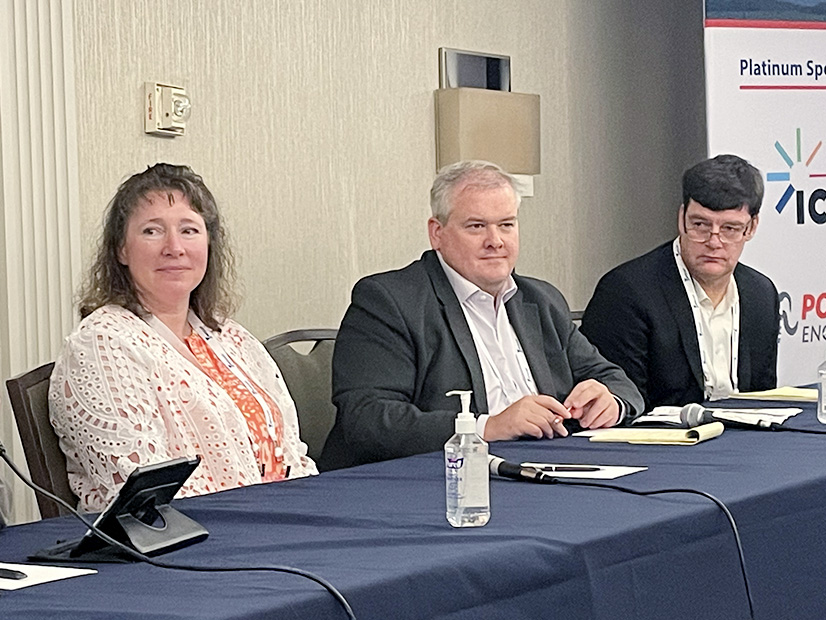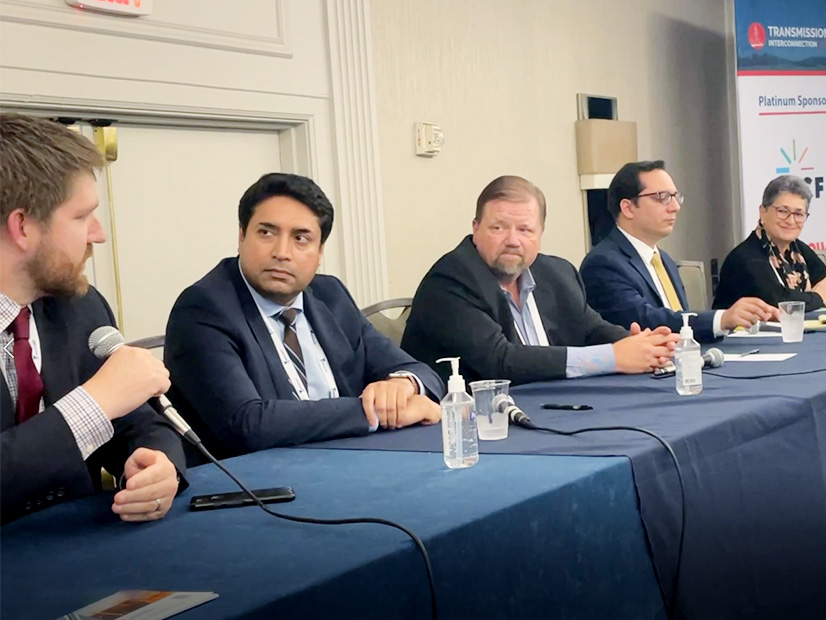
ARLINGTON, Va. — Frustration over the pace of transmission growth and lack of interregional planning mixed with optimism over FERC’s recent proposed rulemakings at Infocast’s Transmission and Interconnection Summit last week.
The sessions also featured debates over the role of grid-enhancing technologies (GETs) and the commission’s proposal to scale back Order 1000’s effort to subject transmission projects to competition. See related stories:
- Planners, Developers: Transmission not Keeping Pace with System Needs
- Ratepayers Protest FERC Retreat on Transmission Competition
- GETs: Long-Term Solution or Niche Player?
- Interconnection Rulemaking Wins Support but Funding Question Remains
Here’s some other highlights.
Overcoming NIMBYism on Transmission
Last August, the Niskanen Center and the Clean Air Task Force released a report that called for adoption of the “5 P framework” to overcome opposition to clean energy infrastructure. The construct builds on the transmission concept of “planning, permitting and paying.”
“We propose adding ‘participation’ as a fourth ‘P’ and then ‘process’ as [the fifth]. Because one of the challenges of transmission [is that] every single project is unique, because every state in every region is different,” said Liza Reed, Niskanen’s electricity transmission research manager for climate policy. “The reason that we raise participation up to an equal level with the other Ps … is that groups are really siloed in each of those policies right now. There is stakeholder engagement in planning. There is stakeholder engagement in permitting. There is stakeholder engagement in paying. But different stakeholders get brought in at different points, and that’s when groups start getting frustrated. And I think when folks hear the word ‘participation,’ they think angry town halls and lawsuits. But the whole point of bringing participation into a consistent process is to avoid that.”
Lawrence Berkeley National Laboratory’s Joseph Rand offered an observation from his analyses on the siting and community impacts of large-scale wind and solar.
“What the wind energy developers have learned over time is that we need to move away from a process that people call ‘decide, announce, defend,’ [to one] called ‘consult, consider, modify, proceed,’ so that you’re meaningfully engaging local stakeholders in that process and being open to actually modifying your proposal,” said Rand, senior scientific engineering associate for the lab’s Electricity Markets and Policy Group.
“What has worked well? When you get consensus, it’s easy for it to work well,” said Ted Thomas, chair of the Arkansas Public Service Commission. “What drove the [MISO] MVP [Multi-Value Project] process was it started with the governors. So you had a political impetus; you had a homogenous policy across the region [MISO North]. You also didn’t have an Order 1000, so the incumbent utility knew that if projects were built that it was going to their rate base; that they [MISO] weren’t going to bid it to somebody else. So you had to political push of the governors, and the political push of the utilities. It created consensus.”
In contrast, Thomas said, the failed 700-mile HVDC Clean Line transmission project from Oklahoma to Arkansas, which the U.S. Department of Energy agreed to support, “had higher negatives than gonorrhea.”
 From left, Michelle L. Manary, Department of Energy, Matthew Nelson, chair of the Massachusetts Department of Public Utilities and Ted Thomas, chair of the Arkansas Public Service Commission | © RTO Insider LLC
From left, Michelle L. Manary, Department of Energy, Matthew Nelson, chair of the Massachusetts Department of Public Utilities and Ted Thomas, chair of the Arkansas Public Service Commission | © RTO Insider LLC
“We have battle scars from that,” joked Michelle L. Manary, acting deputy assistant secretary for DOE’s Energy Resilience Division.
To avoid that problem in the future, Manary said DOE will focus not on transmission corridors but on specific projects.
“It’s much easier to study a specific project,” she said. “And I think it’s easier also for the states and utilities to comment on it and coordinate and facilitate with it because they know what we’re talking about — not just a broad swath of land.”
Thomas said FERC should be “very cautious” in using the backstop siting authority it received in the Infrastructure Investment and Jobs Act.
“I think you want a pretty recalcitrant state — a situation where it’s pretty clearly against the public interest,” he said. “Because if you do that push, there’s going to be a push back.”
Go Big
Grid Strategies’ Jay Caspary, a former SPP planner, complimented the RTO and MISO for their Joint Targeted Interconnection Queue (JTIQ) study, which identified seven 345-kV projects totaling $1.65 billion on their seam. But he said the RTOs should consider double-circuit lines instead of the current plans for single circuits. “What we found from the MVPs — as well as the priority projects in SPP and other projects that have been approved — is they’re all oversubscribed within one or two years of going into service,” Caspary said.
Interregional Planning
 Juan Hayem, Invenergy | © RTO Insider LLC
Juan Hayem, Invenergy | © RTO Insider LLC
Juan Hayem, vice president of interconnections and grid analysis for Invenergy, likened RTOs to slabs of concrete on a highway, which are “very hard and very tough.”
“But the middle [of the seam] should be like an expansion joint that allows the two systems to work together properly. I think some of the issues that we’re seeing right now is the expansion joint is missing and the two slabs of concrete are hammering at each other every time something changes, creating disruptions for everybody. So I think there’s a need to have that soft area there at the seams that allows for the proper coordination, the proper definition of projects.”
Resilience
Consultant Alison Silverstein said grid planners concerned with resilience to climate change are “drawing the aperture too small.”
 Devin Hartman, R Street (left), moderated a panel on scenario-based planning with (L-R) Kamran Ali, American Electric Power; Kip Fox, Electric Transmission Texas; Robin Dutta, SunPower and consultant Alison Silverstein. | © RTO Insider LLC
Devin Hartman, R Street (left), moderated a panel on scenario-based planning with (L-R) Kamran Ali, American Electric Power; Kip Fox, Electric Transmission Texas; Robin Dutta, SunPower and consultant Alison Silverstein. | © RTO Insider LLC
“The reality of climate change is such that we need to be thinking about resilience from the customer up, and for an entire set of systems and communities that are much bigger than just the grid,” she said. “When you look at the magnitude and ferocity and frequency of Hurricane Ida, Hurricane Harvey, California wildfires, Winter Storm Uri — all of these things are orders of magnitude worse than anything we ever designed most of the assets on. … We designed this grid for Ozzie and Harriet when we are facing Mad Max, and our systems are caving again and again under the magnitude of the storms that are hitting them.
“So planning how to improve the power system for resilience really needs to start with how do we protect customers against all of the things that are going to go bad,” she added. “Let’s start by protecting customers with energy efficiency and a whole lot of distributed assets. Not just community solar, community storage; a whole lot of things: community warming centers so that people can survive while you’re trying to put the grid back together.”



